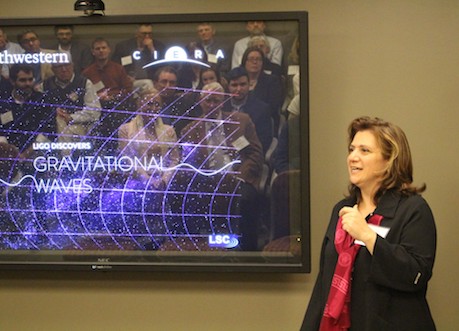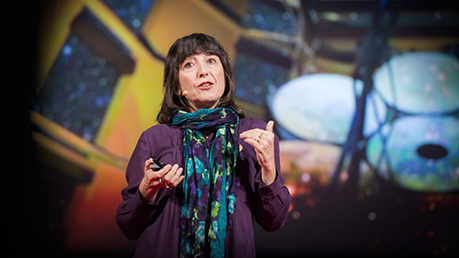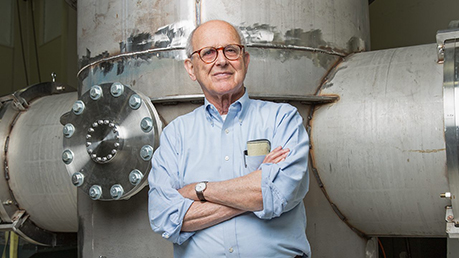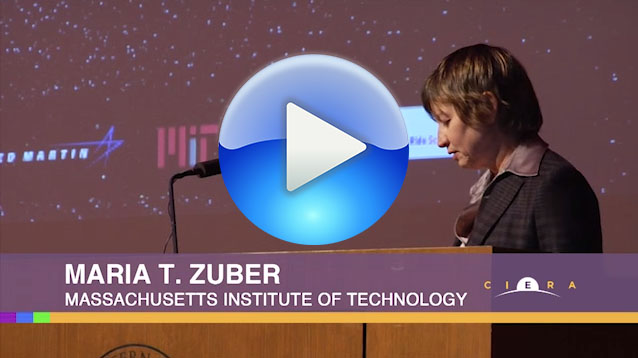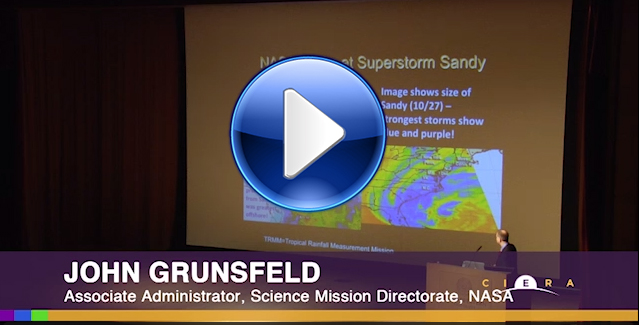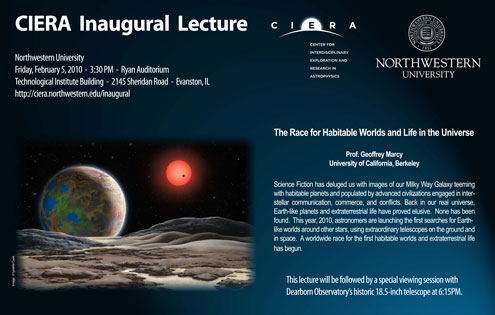For the Public | CIERA Annual Public Lecture Series
"The NU Astronomy of Stars, Black Holes, and Cosmic Explosions"
Daniel I. Linzer Distinguished University Professor of
Physics and Astronomy, Northwestern University
Director, CIERA
Thursday, October 11th, 2018
5:00pm
Northwesterns Cahn Auditorium
Please RSVPTo receive updates about this and other CIERA Events,
please subscribe to our e-mail list.
Celebrate TEN YEARS OF ASTRONOMY DISCOVERIES by the faculty, postdocs, and students of CIERA, Northwesterns astronomy research center. Learn how our understanding of the lives of stars and their influence on the Cosmos has changed over the past ten years. The story will range from how stars live and die, to how we study their remains with light and gravity, in order to untangle the evolution of the galaxy and Universe. The lecture will feature the core stories of how our work in CIERA has helped push those frontiers of understanding. Stay after the lecture for a special Ask an Astronomer meet-and-greet with Northwestern astronomers.
"The Unexpected Universe: Astronomical Telescopes
Continue to Reveal New Surprises"
John & Marion Sullivan University Professor of Astronomy & Astrophysics
Department of Astronomy and Astrophysics, University of Chicago
Kavli Institute for Cosmological Physics
Thursday, October 5th, 2017
7:30pm
Northwesterns Cahn Auditorium
To receive updates about this and other CIERA Events,
please subscribe to our e-mail list.
Wendy Freedman's research is in observational cosmology (measures of the expansion rate of the universe using the Hubble Space Telescope, Spitzer Space Telescope and the ground-based Magellan telescope). Her current projects involve measurements of the Hubble constant -- the current expansion rate, as well as the past expansion rate, providing constraints on the acceleration of the universe and dark energy. Her other field of interest is the stellar populations of galaxies, the evolution of galaxies, and the initial mass function.
Talk Abstract:
Cosmology in recent decades has been undergoing a revolution. Astronomers have for the first time identified the major constituents of the universe, revealing a universe that hardly resembles what we thought only a few decades ago. It is filled with dark matter that is not visible and energy that permeates all of space, causing its expansion to speed up with time. Thousands of planets are now being discovered beyond our Solar System. New giant telescopes planned for the next decade are likely to reveal more surprises. In her lecture, Professor Freedman will describe these exciting advances.
Watch Prof. Freedmans TED Talk.
"Beginning the Exploration of the Universe with Gravitational Waves"
Professor of Physics, Emeritus
Massachusetts Institute of Technology, on behalf of the
Laser Interferometer Gravitational-Wave Observatory (LIGO) Scientific Collaboration
Tuesday, May 2nd, 2017
6:00pm
Northwesterns Technological Institute,
Room LR3 (enter through the main entrance, turn right)
To receive updates about this and other CIERA Events,
please subscribe to our e-mail list.
Dr. Rainer Weiss is a preeminent physicist who for 40 years has worked toward the first direct detection of gravitational waves announced in 2016. Dr. Weiss is professor of physics emeritus at MIT and is one of the founders of LIGO, the instrument that first heard gravitational waves emit from the merging of two supermassive black holes 1.3 billion light years from Earth. Dr. Weiss developed the concept behind LIGO as an exercise for a course on general relativity that he taught at MIT in 1967. Today the LIGO Collaboration is comprised of over 1,000 scientists and engineers world-wide.
Talk Abstract:
The recent observation of gravitational waves from the merger of binary black holes opens a new way to learn about the universe as well as to test General Relativity in the limit of strong gravitational interactions the dynamics of massive bodies traveling at relativistic speeds in a highly curved space-time. The lecture will describe some of the difficult history of gravitational waves proposed exactly 100 years ago. The concepts used in the instruments and the methods for data analysis that enable the measurement of gravitational wave strains of 10-21 and smaller will be presented. The results derived from the measured waveforms, their relation to the Einstein field equations and the astrophysical implications are discussed. The talk will end with our vision for the future of gravitational wave astronomy.
Read Q&A: Rainer Weiss on LIGOs Origins by MIT News.
Read more about Dr. Weisss background in Science Magazine.
View the Northwestern News Special Feature on the historic first direct detection of gravitational waves.
"New Horizons and the Exploration of the Pluto System"
Dr. Alan Stern (Southwest Research Institute)
Thursday, November 5th, 2015
5:00 pm
Northwestern University's Technological Institute
Ryan Family Auditorium
Dr. Alan Stern is the Associate Vice President of the Space Science and Engineering Division of the Southwest Research Institute. For the past 14 years, he has also served as the Principal Investigator for NASAs New Horizons mission to Pluto; he is widely regarded as the driving force behind making the mission. The New Horizons probe is the first mission to explore Pluto and its system of satellites; afterwards, it will fly on to explore the Solar System beyond Pluto.
Dr. Stern is highly qualified to be leading this mission: his research focuses on studies of objects in our Solar System beyond Neptune (the Kuiper Belt and Oort Cloud), the satellites of the outer planets, and the atmospheres of moons in the solar system, among many other topics. He earned his doctorate in astrophysics at the University of Colorado at Boulder, and holds master of science degrees in atmospheric science and aerospace engineering from the University of Texas at Austin. Besides his work on New Horizons, he has developed eight other scientific instruments for near-Earth and planetary research missions.
He has been honored as a Fellow of the American Association for the Advancement of Science, a Fellow of the American Geophysical Union, and was named in 2007 as one of Time magazines 100 most influential people in the world. Most recently, he was named an honorary Fellow of the Royal Astronomical Society and selected to receive the Smithsonians 2015 American Ingenuity Award.
CIERA Sixth Annual Public Lecture
"This Just In: Latest Discoveries in the Universe"
Dr. Neil deGrasse Tyson
Astrophysicist and Frederick P. Rose Director
Hayden Planetarium
American Museum of Natural History

Photograph by Chris Cassidy (casspix.com)
Thursday, May 14th, 2015
8:00 pm
Northwestern University's Technological Institute
Ryan Family Auditorium
Neil deGrasse Tyson is best known for his extraordinary science education work, as well as his accomplishments as an astrophysicist. Besides his scientific work, Dr. Tyson has released ten books and made many public appearances, communicating not only how the Universe works, but his excitement and passion for understanding the world around him. Tyson hosted the PBS program “NOVA scienceNOW”, as well as “Cosmos: A SpaceTime Odyssey”, which received critical acclaim and was nominated for 12 Emmys, winning four. He also is the host of StarTalk Radio, a popular astronomy radio program.
Tyson is the fifth head of the Hayden Planetarium in New York City and the first occupant of its Frederick P. Rose Directorship. He is also a research associate of the Department of Astrophysics at the American Museum of Natural History. He has received eighteen honorary doctorates, as well as the NASA Distinguished Public Service Medal. Dr. Tyson has also served on commissions for the Implementation of United States Space Exploration Policy and the Future of the US Aerospace Industry, as well as NASA's Advisory Council.
Thanks to Northwestern's Society of Physics Students, the students of Northwestern's Contemporary Thought Speaker Series, and Northwestern University's Space Technology and Rocketry Society for all of their help, in the early days of planning this event.
The organizers also wish to thank Norris Special Events group for their help with this event, and the Office of the President at Northwestern University for their assistance.
Special thanks to all of the sponsors who contributed funds to make this talk possible:
Department of Northwestern University |
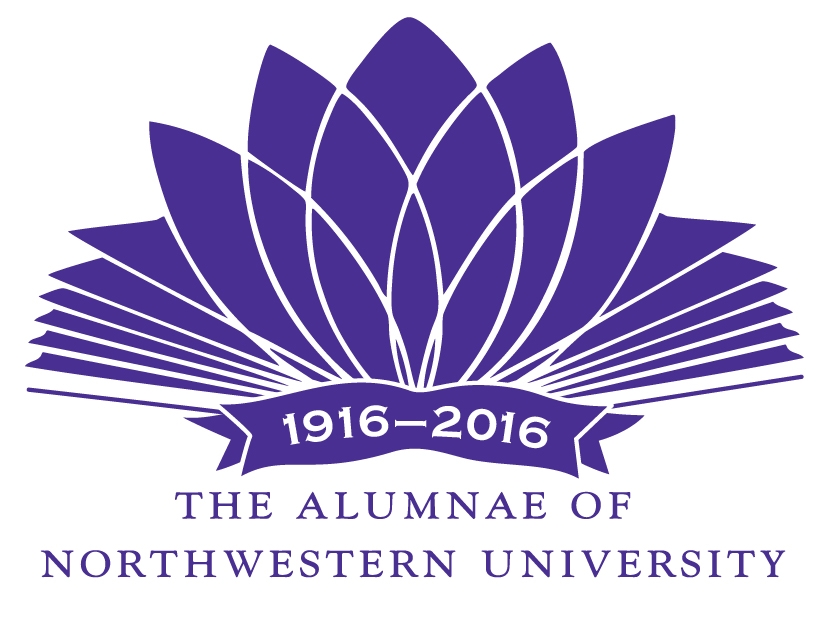 |

Northwestern University's |
 |
Northwestern University's |
CIERA Fifth Annual Public Lecture
"Old Moon, New Moon"
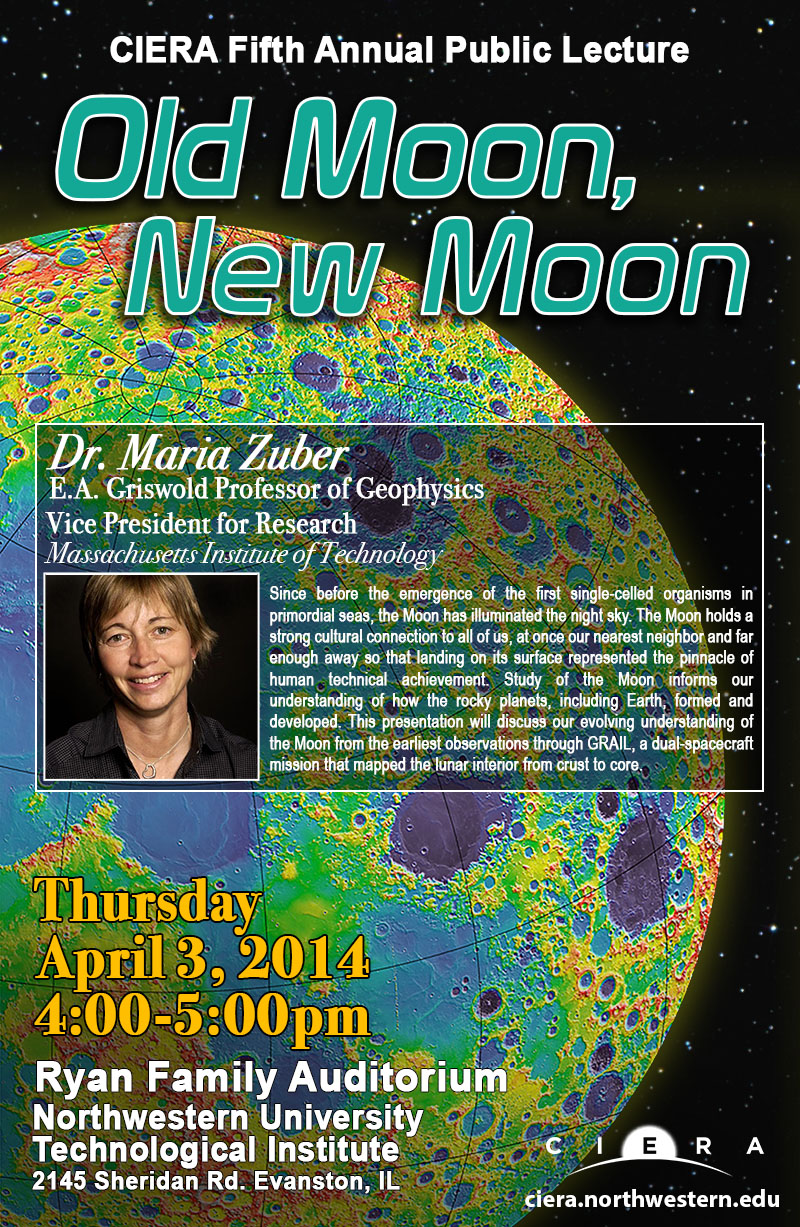 |
|
(E.A. Griswold Professor of Geophysics, Vice President for Research at MIT)
April 3 rd, 2014
4:00pm at Tech Ryan Auditorium
This Event is FREE to the Public.
ABSTRACT: Since before the emergence of the first single-celled organisms in primordial seas, the Moon has illuminated the night sky. The Moon holds a strong cultural connection to all of us, at once our nearest neighbor and far enough away so that landing on its surface represented the pinnacle of human technical achievement. Study of the Moon informs our understanding of how the rocky planets, including Earth, formed and developed. This presentation will discuss our evolving understanding of the Moon from the earliest observations through GRAIL, a dual-spacecraft mission that mapped the lunar interior from crust to core.
BIOGRAPHY: Dr. Maria Zuber is the E.A. Griswold Professor of Geophysics (in the Department of Earth, Atmospheric, and Planetary Sciences) and Vice President of Research at the Massachusetts Institute of Technology in Cambridge, Massachusetts. Dr. Zuber has led the development of a wide range of instruments that have ventured to Mars, Mercury, and the Moon on a variety of NASA missions. Her interests lie in understanding the structure and tectonics of solid planets in our inner solar system through the use of laser and radio tracking experiments on spacecraft. In addition, her group is currently developing an instrument to search for DNA and RNA on the surface of Mars.
Among her many honors, she was appointed by President Obama to the National Science Board, was Chair of the MIT Department of Earth, Atmospheric, and Planetary Sciences from 2003 to 2011 (and was the first woman to lead a science department at MIT), was named one of America's Best Leaders by U.S. News and World Report in 2012, was listed as one of the 50 Most Important Women in Science by Discover Magazine in 2002, and has won numerous awards including: the Harry H. Hess Medal of the American Geophysical Union, MIT's James R. Killian Jr. Faculty Award, a NASA Distinguished Service Medal, and many NASA Achievement awards for her work on nine different NASA missions. She has held distinguished lectureships at the Niels Bohr Institute, Harvard University, Cornell University, Stanford University, and at the American Institute of Aeronautics and Astronautics, among many others.
CIERA Fourth Annual Public Lecture
"Science@NASA"
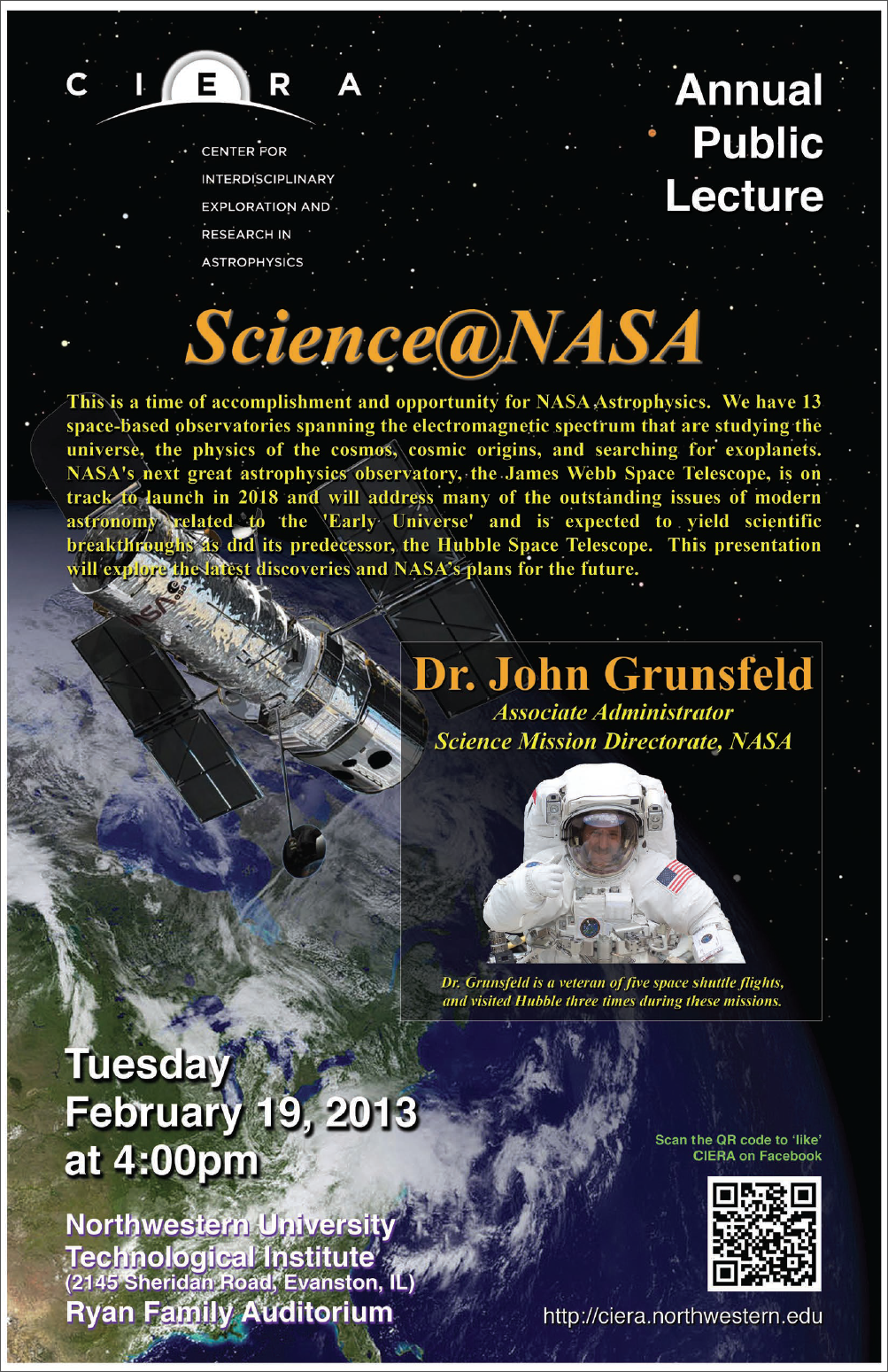 |
|
Dr. John M. Grunsfeld (NASA)
February 19th, 2013
4:00pm at Tech Ryan Auditorium
ABSTRACT: This is a time of accomplishment and opportunity for NASA Astrophysics. We have 13 space-based observatories spanning the electromagnetic spectrum that are studying the universe, the physics of the cosmos, cosmic origins, and searching for exoplanets. NASA's next great astrophysics observatory, the James Webb Space Telescope, is on track to launch in 2018 and will address many of the outstanding issues of modern astronomy related to the 'Early Universe' and is expected to yield scientific breakthroughs as did its predecessor, the Hubble Space Telescope. This presentation will explore the latest discoveries and NASAs plans for the future.
BIOGRAPHY: John Grunsfeld is the Associate Administrator for the Science Mission Directorate at NASA Headquarters in Washington, D.C. He previously served as the Deputy Director of the Space Telescope Science Institute in Baltimore, managing the science program for the Hubble Space Telescope and the forthcoming James Webb Space Telescope. Grunsfelds background includes research in high energy astrophysics, cosmic ray physics and in the emerging field of exoplanet studies with specific interest in future astronomical instrumentation.
Grunsfeld joined NASA's Astronaut Office in 1992. He is veteran of five space shuttle flights, and visited Hubble three times during these missions. He also performed eight spacewalks to service and upgrade the observatory. He logged more than 58 days in space on his shuttle missions, including 58 hours and 30 minutes of spacewalk time. Grunsfeld first flew to space aboard Endeavour in March 1995 on a mission that studied the far ultraviolet spectra of faint astronomical objects using the Astro-2 Observatory. His second flight was aboard Atlantis in January 1997. The mission docked with the Russian space station Mir, exchanged U.S. astronauts living aboard the outpost, and performed scientific research using the Biorack payload. He also flew on Discovery in December 1999, Columbia in March 2002 and Atlantis in May 2009. This last flight successfully serviced and upgraded the Hubble Space Telescope, during which he was lead spacewalker for Hubble servicing activities. In 2004 and 2005, he served as the commander and science officer on the backup crew for Expedition 13 to the International Space Station.
Grunsfeld graduated from the Massachusetts Institute of Technology in 1980 with a bachelor's degree in physics. He subsequently earned a master's degree and, in 1988, a doctorate in physics from the University of Chicago using a cosmic ray experiment on space shuttle Challenger for his doctoral thesis. From Chicago, he joined the faculty of the California Institute of Technology as a Senior Research Fellow in Physics, Mathematics and Astronomy.
CIERA Third Annual Public Lecture
"Dark Energy and the Accelerating Universe:
Einstein's Blunder Undone"
 |
To view Prof. Kirshner's talk, click on the play button above. |
Prof. Robert Kirshner (Harvard-Smithsonian CfA)
November 1st, 2011
4:00pm at Tech Ryan Auditorium
Exploding stars halfway across the universe reveal an extraordinary fact: the expansion of the universe is speeding up. We attribute this to a dark energy that acts to make the universe spring apart. The resulting picture is a truly strange one: most of the universe is in the form of dark matter we cannot see and dark energy we do not yet understand. Only 4% of the mass-energy of the universe is in the form of atoms that can make stars, galaxies, planets, and people. This talk will show how we know the universe is accelerating and sketch how today's idea of dark energy resembles Einstein's cosmological constant, an idea he invented in 1916 and discarded in 1931.
Robert Kirshner is Clowes Professor of Science at Harvard University. A 1970 graduate of Harvard College, Kirshner received his Ph. D. from Caltech and recently received an honorary Doctor of Science degree from the University of Chicago. His work with the High-Z Supernova team helped uncover the fact that the expansion of the universe is speeding up. Kirshner shared in the 2007 Gruber Prize in Cosmology for that work. Kirshner won the 2011 Heineman Prize for "his sustained and enduring contributions to our understanding of supernovae and cosmology." A frequent public lecturer on astronomy, he teaches a large undergraduate course at Harvard called "The Energetic Universe" and is the author of popular-level book The Extravagant Universe: exploding stars, dark energy, and the accelerating cosmos.
For the article by Science in Society about this research, please see "Our Rapidly Expanding Universe", an interview with Prof. Kirshner by Beth Herbert here.
The Chicago Tribune has a story online in their TribLocal (Evanston) section here!
CIERA Second Annual Public Lecture
"The Warped Side of our Universe:
From the Big Bang to Black Holes and Gravitational Waves"
Prof. Kip S. Thorne (California Institute of Technology)
October 18th, 2010
4:00pm at Fisk Hall
There is a Warped Side to our Universe: objects and phenomena that are made from warped space and warped time. Three examples are black holes, the big-bang in which our Universe was born, and ripples in the fabric of space-time called gravitational waves. Thorne will describe the Warped Side of our Universe and the quest to probe it theoretically using computer simulations, and observationally using gravitational waves.
Kip Thorne is Feynman Professor of Theoretical Physics, Emeritus, at Caltech. Dr. Thorne is one of the world's leading experts on the astrophysical implications of Einstein's general theory of relativity, known for his prolific contributions in gravitational physics and astrophysics. He is currently working on a film with Steven Spielberg.
CIERA Inaugural Public Lecture
"The Race for Habitable Worlds and Life in the Universe"
Prof. Geoffrey Marcy (University of California, Berkeley)
February 5th, 2010
3:30pm at Tech Ryan Auditorium
Science Fiction has deluged us with images of our Milky Way Galaxy teeming with habitable planets and populated by advanced civilizations engaged in inter-stellar communication, commerce, and conflicts. Back in our real universe, Earth-like planets and extraterrestrial life have proved elusive. None has been found. This year, 2010, astronomers are launching the first searches for Earth-like worlds around other stars, using extraordinary telescopes on the ground and in space. A worldwide race for the first habitable worlds and extraterrestrial life has begun.
This lecture will be followed by a special viewing session with Dearborn Observatory's historic 18.5-inch telescope at 6:15pm.
